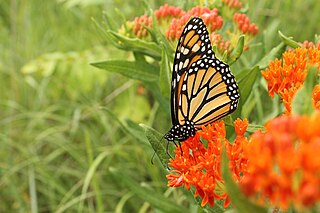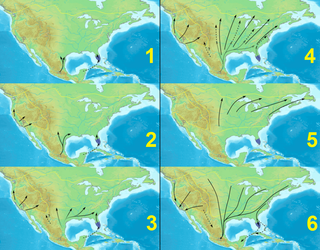
Danainae is a subfamily of the family Nymphalidae, the brush-footed butterflies. It includes the Daniadae, or milkweed butterflies, who lay their eggs on various milkweeds on which their larvae (caterpillars) feed, as well as the clearwing butterflies (Ithomiini), and the tellervini.

The monarch butterfly or simply monarch is a milkweed butterfly in the family Nymphalidae. Other common names, depending on region, include milkweed, common tiger, wanderer, and black-veined brown. It is amongst the most familiar of North American butterflies and an iconic pollinator, although it is not an especially effective pollinator of milkweeds. Its wings feature an easily recognizable black, orange, and white pattern, with a wingspan of 8.9–10.2 cm (3.5–4.0 in). A Müllerian mimic, the viceroy butterfly, is similar in color and pattern, but is markedly smaller and has an extra black stripe across each hindwing.

Asclepias is a genus of herbaceous, perennial, flowering plants known as milkweeds, named for their latex, a milky substance containing cardiac glycosides termed cardenolides, exuded where cells are damaged. Most species are toxic to humans and many other species, primarily due to the presence of cardenolides. However, as with many such plants, some species feed upon them or from them. The most notable of them is the monarch butterfly, which uses and requires certain milkweeds as host plants for their larvae.

Asclepias syriaca, commonly called common milkweed, butterfly flower, silkweed, silky swallow-wort, and Virginia silkweed, is a species of flowering plant. It is native to southern Canada and much of the United States east of the Rocky Mountains, excluding the drier parts of the prairies. It is in the genus Asclepias, the milkweeds. It grows in sandy soils as well as other kinds of soils in sunny areas.
Ophryocystis elektroscirrha is an obligate, neogregarine protozoan parasite that infects monarch and queen butterflies. There are no other known hosts. The species was first discovered in Florida, around the late 1960s. Since then, it has been found in every monarch population examined to date, including monarchs sampled in North America, Hawaii, Australia, Cuba, and Central and South America.

The queen butterfly is a North and South American butterfly in the family Nymphalidae with a wingspan of 80–85 mm. It is orange or brown with black wing borders and small white forewing spots on its dorsal wing surface, and reddish ventral wing surface fairly similar to the dorsal surface. The ventral hindwings have black veins and small white spots in a black border. The male has a black androconial scent patch on its dorsal hindwings. It can be found in meadows, fields, marshes, deserts, and at the edges of forests.

Butterfly gardening is a way to create, improve, and maintain habitat for lepidopterans including butterflies, skippers, and moths. Butterflies have four distinct life stages—egg, larva, chrysalis, and adult. In order to support and sustain butterfly populations, an ideal butterfly garden contains habitat for each life stage.

Insect migration is the seasonal movement of insects, particularly those by species of dragonflies, beetles, butterflies and moths. The distance can vary with species and in most cases, these movements involve large numbers of individuals. In some cases, the individuals that migrate in one direction may not return and the next generation may instead migrate in the opposite direction. This is a significant difference from bird migration.

A cardenolide is a type of steroid. Many plants contain derivatives, collectively known as cardenolides, including many in the form of cardenolide glycosides (cardenolides that contain structural groups derived from sugars). Cardenolide glycosides are often toxic; specifically, they are heart-arresting. Cardenolides are toxic to animals through inhibition of the enzyme Na+/K+‐ATPase, which is responsible for maintaining the sodium and potassium ion gradients across the cell membranes.

Many populations of Lepidoptera migrate, sometimes long distances, to and from areas which are only suitable for part of the year. Lepidopterans migrate on all continents except Antarctica, including from or within subtropical and tropical areas. By migrating, these species can avoid unfavorable circumstances, including weather, food shortage, or over-population. In some lepidopteran species, all individuals migrate; in others, only some migrate.

Danaus erippus, the southern monarch, is a milkweed butterfly in the family Nymphalidae. It is one of the best known butterflies in South America. Its genome is nearly identical to D. plexippus, but the two are incompatible, and therefore considered separate species.

Asclepias viridis is a species of milkweed, a plant in the dogbane family known by the common names green milkweed, green antelopehorn and spider milkweed. The Latin word viridis means green. The plant is native to the midwestern, south central and southeastern United States, as well as to the southeastern portion of the western United States.
Lespesia archippivora is a species of tachinid fly, which, like all tachinids, are parasitoids of other arthropods. L. archippivora lives in the body of its host resulting in its death. This is not uncommon since it is estimated that about 10% of all insects are parasitoids. L. archippivora is a generalist and able to infect at least 25 lepidopteran species in addition to one species of Hymenoptera. It is common in North America and other species exist worldwide. One study suggests the species is bivoltine.

Monarch butterfly migration is the phenomenon, mainly across North America, where the subspecies Danaus plexippus plexippus migrates each summer and autumn to and from overwintering sites on the West Coast of California or mountainous sites in Central Mexico. Other subspecies perform minor migrations or none at all. This massive movement of butterflies has been called "one of the most spectacular natural phenomena in the world".
The U.S. state of California has instituted numerous conservation programs, policies, laws, reserves and Habitat restoration projects throughout the state to facilitate the health and migration of the western population of the monarch butterfly. The population of western monarchs require very different breeding and overwintering habitat when compared to the eastern population of monarch butterflies. They require specific micro-climatic conditions to survive the winter and they are sensitive to habitat changes at the overwintering sites. The large aggregations of butterflies are seen as the most vulnerable at their overwintering locations along the coast. Many monarch overwintering sites are contained within the "coastal zone"; an area defined by the Coastal Zone Management Act to be 1000 yards inland from the high tide mark. Large number of overwintering sites are outside the coastal zone. There are more than 450 overwintering sites in California.
eButterfly is a real-time, online database and photo storage program. It provides a way for the butterfly community to report, organize, and access information about butterflies in Central and North America and the Caribbean. eButterfly provides detailed sources for basic data on butterfly abundance, distribution, and phenology at a variety of spatial and temporal scales across the region. eButterfly is maximizing the utility and accessibility of the vast numbers of butterfly observations, photographs, and collections made each year by recreational and professional butterfly enthusiasts. Observations can be entered directly to the eButterfly website. As of March 2021, eButterfly users have contributed over 429,000 observations.

Lincoln Pierson Brower was an American entomologist and ecologist, known for his work on monarch butterflies, chemical ecology and conservation.

Monarch Watch is a volunteer-based citizen science organization that tracks the fall migration of the monarch butterfly. It is self-described as "a nonprofit education, conservation, and research program based at the University of Kansas that focuses on the monarch butterfly, its habitat, and its spectacular fall migration."

Pteromalus cassotis is a species of parasitic wasp in the family Pteromalidae that parasitizes the chrysalides of monarch butterflies. They are gregarious parasitoids, meaning a single female lays many eggs in a single host. Research into this species has documented that up to 425 adult wasps can emerge from a single chrysalis. The wasps have a heavy female bias, averaging 90% female. Maximum entropy models suggest that the natural habitat of this species encompasses the continental United States, southern Canada and parts of Mexico; areas inhabited by the caterpillars of monarch butterflies, which are the larvae's hosts.
Myron P. Zalucki is an Australian professor emeritus of entomology at the University of Queensland (UQ). Zalucki is a Fellow of the Entomological Society of America, a member and secretary of the Council of the International Congresses of Entomology, and a co-editor of the Annual Review of Entomology.















